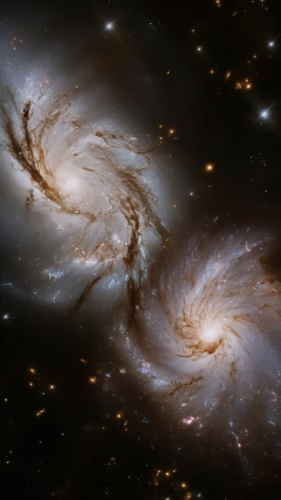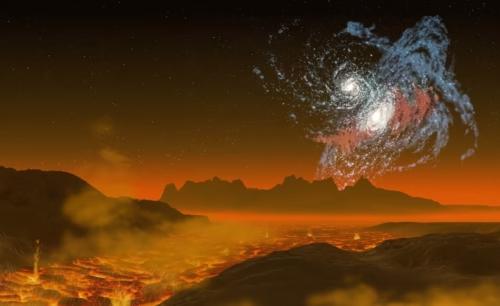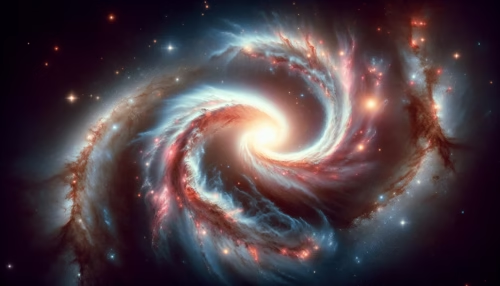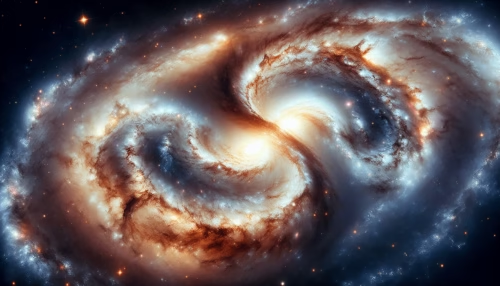Have you ever wondered what happens when galaxies collide, particularly our Milky Way and its neighboring galaxies? Such cosmic events might seem far removed from our daily lives, but they hold crucial keys to understanding the universe’s past and future. With numerous galaxies existing in our universe, their interactions are frequent and complex. The future of our own Milky Way has been a subject of much curiosity and scientific inquiry, especially considering its expected collision with the Andromeda Galaxy. This article, “When Galaxies Collide: Unveiling the Milky Way’s Future,” aims to unravel the mysteries associated with such galactic phenomena, providing you with detailed insights into the inevitability, process, and outcomes of these majestic astronomical events.

Table of Contents
Understanding Galactic Collisions
Galactic collisions are not as immediately catastrophic as they sound, primarily because the vast distances between stars mean direct stellar collisions are rare. However, the gravitational forces involved in such interactions significantly impact the structure and future of the galaxies. For you to gain a comprehensive understanding of our galaxy’s future, grasping the mechanics of galactic collisions is crucial.
The Cosmic Dance: How Collisions Begin
Galaxies are bound by gravity, which influences their movement and interactions. Over time, gravitational attractions draw them together, starting a collision process that can last millions of years. The Milky Way is hurtling towards its neighbor, the Andromeda Galaxy, at a speed of about 110 kilometers per second. You might see this as a slow dance, but in astronomical terms, it’s a significant velocity.
Expected Timeline for the Milky Way and Andromeda
Predicting the exact timeline for a galactic collision involves complex calculations and simulations. Current estimations suggest that the Milky Way and Andromeda will collide in around 4.5 billion years. While this seems like a distant future, it’s imminent in the grand timeline of the universe. It’s important for you to understand the phases leading up to and following such a monumental event.
Historical Context of Galactic Collisions
While the concept might seem uniquely futuristic, galactic collisions have been shaping the universe since nearly its inception. By studying these past interactions, scientists can offer insights into the forthcoming collision between the Milky Way and Andromeda.
Past Galactic Collisions in Our Universe
Many galaxies we see today have been shaped by previous collisions and mergers. For instance, elliptical galaxies, often found in dense galaxy clusters, are typically the result of numerous mergers. These historical events give you an indication of how prevalent and influential galactic collisions are in the universe.
The Role of Collisions in Galactic Evolution
Galactic collisions are fundamental in shaping the structure and evolution of galaxies. During such processes, galaxies undergo significant transformations, including triggering star formation, altering their shape, and even merging black holes at their centers. You can see this evolution as the universe’s way of recycling and reinventing its cosmic architecture.

The Collision Process: What Happens During a Galactic Merger
Understanding the intricate process of galactic mergers provides a clearer picture of what to expect when the Milky Way finally meets Andromeda.
Initial Contact and Gravitational Interactions
As galaxies draw closer, their respective gravitational fields interact, causing distortions in their shapes and accelerating the motion of stars within them. You’ll find this initial phase to be a period of increasing turbulence and energy within the galaxy’s structure.
Star Formation and Black Hole Activity
The immense gravitational forces from a collision can compress gas clouds, leading to bursts of star formation. These starbursts are a significant and observable outcome of galactic mergers. Furthermore, the central black holes of colliding galaxies may eventually merge, releasing vast amounts of energy. This aspect highlights a critical period of growth and activity within galaxies.
Final Merger and New Galaxy Formation
The ultimate stage of a galactic collision involves the merging of two galactic cores, leading to the formation of a new, often elliptical, galaxy. It’s an amalgamation of stars, gas, and dark matter from both galaxies. For the Milky Way, this might mean a complete transformation into a new type of galaxy, possibly with a different structure and future potential.
The Consequences of Galaxies Colliding
Understanding the aftermath of a galactic collision is as intriguing as the collision itself. The consequences for both galaxies involved are profound and long-lasting.
Structural Changes in the Milky Way
The Milky Way is a barred spiral galaxy. Post-collision, its structure might evolve, possibly losing its spiral arms and adopting a more elliptical shape. For observers within the galaxy, these changes would alter the night sky dramatically over millions of years.
Potential Impacts on Our Solar System
One of the most pertinent questions you might have concerns the fate of our solar system. While individual stars seldom collide, our solar system could be displaced from its current orbit around the Milky Way’s center, altering our cosmic neighborhood significantly. Fortunately, the Earth is unlikely to face destruction from the collision, but the night sky and possibly Earth’s climatic patterns could be impacted.
Long-term Galactic Evolution
The end result of the Milky Way-Andromeda collision might be a larger galaxy, often humorously dubbed “Milkomeda.” Such mergers often lead to increased stability and reduced star formation as galaxies age. For our descendants, inhabiting this newly formed galaxy could mean witnessing a universe that looks quite different from today’s perspective.

Case Studies: Evidence from Other Galactic Collisions
Current astronomical technology allows us to observe ongoing and past galactic collisions across the universe. These observations serve as a valuable reference to predict our Milky Way’s fate.
Observing the Antennae Galaxies
The Antennae Galaxies are a vivid example of two galaxies in the midst of collision. Their chaotic and intertwined appearance offers a window into the dynamic processes that our Milky Way might experience. They showcase the stunning star formation and gravitational tussle characteristic of such collisions.
| Galaxy Pair | Characteristics | Relevance to Milky Way |
|---|---|---|
| Antennae Galaxies | Intertwined structure, starbursts | Demonstrates star formation and gravitational changes |
| Mice Galaxies | Long tidal tails, merging cores | Illustrates shape changes and core interactions |
NGC 4038/39: Another Collision in Progress
Also known as the Antennae, NGC 4038/39 displays long tidal tails and active star formation, similar to the future expectations for the Milky Way. This ongoing merger shows the stages our galaxy might undergo, including massive bursts of star creation resulting from gas compression.
The Role of Dark Matter in Galactic Mergers
Dark matter is an unseen yet essential component of galaxies, profoundly influencing their mass and gravitational dynamics. Understanding its role is crucial in appreciating the full scope of galactic collisions.
Understanding Dark Matter’s Contribution
Dark matter makes up a significant portion of a galaxy’s mass, acting as the gravity glue that holds them together. In a collision, the dark matter halos of galaxies interact, facilitating the merger process and influencing the resultant galaxy’s structure.
Insights from Simulations of Dark Matter
Simulations of galactic collisions incorporating dark matter reveal the overarching role it plays in shaping the resulting structures and dynamics. These insights provide a more complete picture of how future events, like the Milky Way-Andromeda collision, will unfold, emphasizing dark matter’s pivotal, albeit invisible, role.

Technological Advancements and Methodologies in Studying Collisions
The study of galactic collisions has advanced significantly, thanks to improvements in observation and simulation technologies.
Telescope Innovations
Modern telescopes, like the Hubble Space Telescope and the upcoming James Webb Space Telescope, provide astronomers with high-resolution, long-range views of galaxies in various stages of collision. These advancements enable a detailed study of the processes over time, offering you glimpses into our galaxy’s future on an unprecedented scale.
Role of Computer Simulations
Computer simulations have revolutionized our understanding of galactic dynamics. By modeling the gravitational interactions and star formation processes, these simulations offer a predictive look at galactic evolution, refining our predictions for events like the impending Milky Way-Andromeda merger.
Future Trends and Emerging Technologies in Galactic Research
The field of galactic research is ever-evolving, with emerging technologies promising to deepen your understanding of cosmic interactions.
Potential of Artificial Intelligence
Artificial intelligence (AI) is increasingly being utilized to analyze vast amounts of astrophysical data, identifying patterns and trends in galactic behavior that humans might overlook. AI could play a pivotal role in advancing our comprehension of galactic mergers and predicting their outcomes more precisely.
Gravitational Wave Astronomy
Gravitational waves, ripples in spacetime caused by massive cosmic events like black hole mergers, open up a new observational dimension. Though detecting these waves from galactic collisions is still in its infancy, it holds potential for groundbreaking insights into stellar and galactic evolution.
Conclusion: Reflecting on the Milky Way’s Future
In conclusion, the collision between the Milky Way and Andromeda represents a fascinating chapter in our universe’s story. By understanding the processes, consequences, and technology behind studying galactic mergers, you gain a deeper appreciation for the cosmic forces shaping our future.
Galactic collisions are a testament to the dynamic nature of the universe, highlighting not only the forces at play on astronomical scales but also the potential for transformation and renewal. As research advances, so too will our understanding of these incredible phenomena, ensuring the mysteries of when galaxies collide continue to intrigue you and inform scientific inquiry for generations to come.
Additional Resources
As you continue to explore the wonders of our universe, several resources can enhance your understanding of galactic phenomena:
- NASA’s Hubble Space Telescope: Offers extensive archives of images and data on galaxies and their interactions.
- The European Southern Observatory (ESO): Provides a wealth of research findings and images related to galactic collisions.
- Books and Publications: Consider titles like “An Introduction to Galaxies and Cosmology” for a more thorough academic exploration of galactic dynamics.
By delving into these resources, you can expand your understanding of galactic collisions and prepare for the ongoing advancements in astronomical research, enriching your knowledge of the universe’s intricate workings.
Has the Milky Way ever collided with another Galaxy?
Unlocking the Mysteries of the Cosmos

